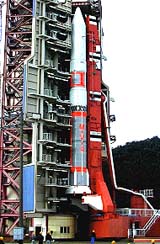| . |  |
. |
 Japan Sends X-ray Scope Into Wrong Orbit
Japan Sends X-ray Scope Into Wrong OrbitTokyo (AFP) February 10, 2000 - Japan lost a 105-million-dollar astronomical satellite after a rocket went awry Thursday, triggering a drastic review of the country's disaster-prone space program, officials said. Television pictures showed the M5 rocket carrying the satellite veering haphazardly 55 seconds after liftoff at 10:30 a.m. (0130 GMT) from Kagoshima Space Centre in Uchinoura, southern Japan. Graphite on the rocket's nozzle appeared to have fallen off, exposing it to heat damage, space centre spokesman Toshiaki Takemae told AFP after the latest in a series of embarassing space flops. "Heat leaks from the crack may have damaged attitude control equipment," he said, leading the rocket to swerve off course and release the satellite into a lower orbit than planned. "We believe the satellite has already re-entered the atmosphere and burned up but we cannot say where and when," said Takemae. Scientists had tried to correct the orbit of the 11.6-billion-yen (105-million-dollar) Astro E satellite by sending commands to its on-board motors, said the Institute of Space and Astronautical Science. But they failed to hear from the errant satellite despite two attempts as it flew over Japan, said the institute's general affairs section chief Yoshihisa Nemoto. Japanese scientists used a 6.8-billion-yen (62-million-dollar) 140-tonne, solid-fuel, three-stage M5 rocket to launch the satellite, which it had planned to use to study X-rays in space. "The outcome is very regrettable," space centre director Yasunori Matogawa told a news conference. The government called for a fundamental review. "There have been repeated failures and we will do our best in probing where the cause of the problem lies," Chief Cabinet Secretary Mikio Aoki told a news conference. "Now that we can see the failures are continuing, of course we will have to consider a fundamental review of the program." The M5, one of the world's largest solid-fuel rockets, was developed by Japan with Nissan Motor Co. Ltd. as the main contractor. It had been used twice before, in 1997 and 1998, without problems. The institute which launched the satellite is part of the education ministry, and is separate from the National Space Development Agency (NASDA), which has had several spectacular failures. Although the latest failure is not a NASDA operation, it further tarnished Japan's reputation in space. "The series of failures give us sufficient reason to be gravely concerned" about Japan's bid for foreign satellite launch contracts, said Hideo Nagasu, advisor to the National Aerospace Laboratory. "In order to restore our reputation, we will have to determine the causes of the failures first, then learn lessons from them and build up successes in future programs," he told AFP. "So it will take time." The 1.7-tonne Astro E, Japan's fifth X-ray observation satellite, was the largest yet launched by the space institute. It carried X-ray observation equipment developed jointly by Japan and the United States. On November 15, NASDA had to explode a 24-billion-yen (229-million-dollar) H-2 rocket and satellite when the rocket's main engine failed, pushing it off course after liftoff. That was second successive failure in the costly H-2 rocket project after a 36-million-dollar satellite was lost in space despite a successful separation from the rocket in February 1998. The H-2 was Japan's answer to Europe's Ariane-4. Copyright 1999 AFP. All rights reserved. The material on this page is provided by AFP and may not be published, broadcast, rewritten or redistributed.
TERRADAILY.COM
|
| |||||||||
| The content herein, unless otherwise known to be public domain, are Copyright 1995-2016 - Space Media Network. All websites are published in Australia and are solely subject to Australian law and governed by Fair Use principals for news reporting and research purposes. AFP, UPI and IANS news wire stories are copyright Agence France-Presse, United Press International and Indo-Asia News Service. ESA news reports are copyright European Space Agency. All NASA sourced material is public domain. Additional copyrights may apply in whole or part to other bona fide parties. Advertising does not imply endorsement, agreement or approval of any opinions, statements or information provided by Space Media Network on any Web page published or hosted by Space Media Network. Privacy Statement All images and articles appearing on Space Media Network have been edited or digitally altered in some way. Any requests to remove copyright material will be acted upon in a timely and appropriate manner. Any attempt to extort money from Space Media Network will be ignored and reported to Australian Law Enforcement Agencies as a potential case of financial fraud involving the use of a telephonic carriage device or postal service. |